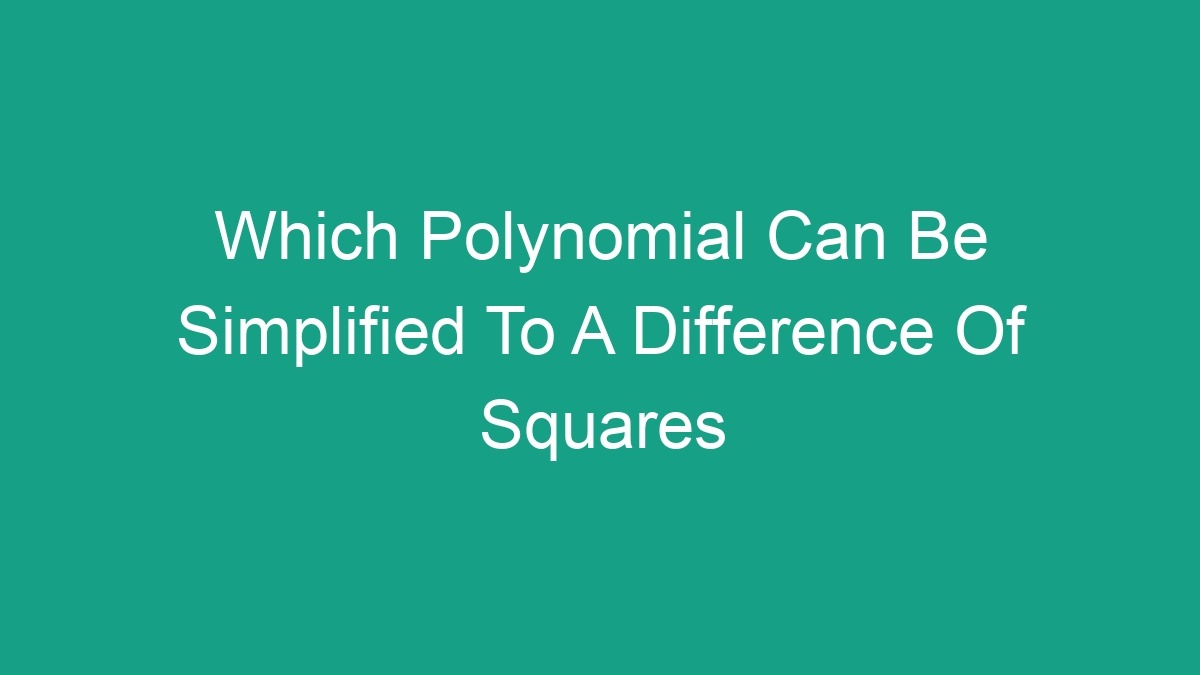
Polynomials are an essential part of algebra, and being able to simplify them can help in various mathematical problems and calculations. One specific type of simplification is turning a polynomial into a difference of squares. Understanding which polynomials can be simplified to a difference of squares is crucial for solving algebraic equations and expressions. In this article, we will explore the concept of a difference of squares, how to identify polynomials that can be simplified to it, and why it is essential in algebraic manipulation.
Understanding the Difference of Squares
Before we delve into identifying which polynomials can be simplified to a difference of squares, it’s crucial to understand what a difference of squares is. A difference of squares is a special case of factoring where a polynomial can be expressed as the product of two binomials. This factorization occurs when a polynomial takes the form of a^2 – b^2, where a and b are variables or constants.
The factored form of a difference of squares is (a + b)(a – b). This presents a significant simplification and is useful in a variety of mathematical problems, including simplifying expressions and solving equations.
Identifying Polynomials for Simplification
Now that we have a basic understanding of what a difference of squares is, let’s explore how to identify polynomials that can be simplified to it. The key to recognizing these polynomials lies in identifying the pattern they exhibit.
General Form of a Difference of Squares
The general form of a difference of squares is a^2 – b^2. When looking at a polynomial, you should be on the lookout for the following characteristics:
- a^2 – This term indicates that the polynomial has a square of a certain variable or constant.
- b^2 – This term indicates that the polynomial has a square of another variable or constant.
- The subtraction sign between a^2 and b^2 – This represents the “difference” in the difference of squares.
If a polynomial exhibits these characteristics, it can be simplified to a difference of squares.
Examples of Polynomials That Can Be Simplified
Here are some examples of polynomials that can be simplified to a difference of squares:
| Polynomial | Simplified Form |
|---|---|
| x^2 – 4 | (x + 2)(x – 2) |
| 9a^2 – 25b^2 | (3a + 5b)(3a – 5b) |
| 16x^2 – 1 | (4x + 1)(4x – 1) |
By observing these examples, you can see how the polynomials exhibit the characteristics of a difference of squares and can be factored accordingly.
Why It’s Important in Algebra
The ability to recognize which polynomials can be simplified to a difference of squares is important in algebra for several reasons:
- Simplification of Expressions: Factoring polynomials into a difference of squares form can simplify complex expressions, making them easier to work with and manipulate.
- Solving Equations: Identifying a polynomial as a difference of squares can aid in solving algebraic equations by factoring them and finding the roots or solutions.
- Patterning and Recognizing Similarities: Understanding the concept of a difference of squares helps in recognizing patterns and similarities in algebraic expressions, leading to a deeper understanding of mathematical concepts.
Conclusion
In conclusion, the ability to identify which polynomial can be simplified to a difference of squares is a fundamental skill in algebra. Understanding the characteristics and patterns of a difference of squares, as well as being able to recognize polynomials that exhibit these traits, is essential for simplifying expressions and solving equations. By mastering this concept, students and mathematicians can enhance their algebraic manipulation skills and gain a deeper understanding of mathematical relationships and patterns.
For anyone studying or teaching algebra, knowing which polynomial can be simplified to a difference of squares is an invaluable skill that can open up new pathways for problem-solving and mathematical exploration.



